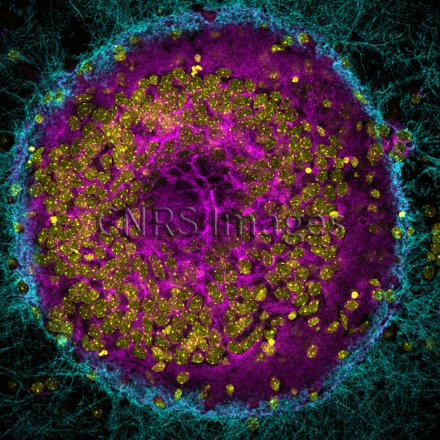Production year
2014

© Fabien LOUSTALOT / Eric KREMER / IGMM / INSERM / CNRS Images
20170076_0002
Neurons in the hippocampus of a mouse observed using a fluorescence confocal microscope, then reconstructed in 2D by projecting the various optical sections onto the Z-plane. The CAR protein was detected using a single antibody. Each colour (cyan blue and violet) represents a series of stacked optical planes (segmentation of the fluorescence signal arbitrarily defined for the somata and dendrites). Violet indicates the neuron somata, cyan blue the neurites and yellow the nuclei. The CAR protein is known to be an adenovirus receptor. As this protein is expressed more strongly in the central nervous system (CNS) during development, research scientists have attempted to identify its role in the establishment of neural networks (neurogenesis). They have discovered that CAR is found in the synapse, a key neuronal substructure that enables neurotransmission, and that this protein is chiefly present in the hippocampus. In murine hippocampal neurons in culture, CAR has been located in structures containing proteins that regulate synaptic activity, such as synaptophysin. This protein could influence adult neurogenesis and/or synaptic plasticity. After this, the scientists created a line of mice in which the gene encoding CAR was specifically impaired in cells of neural origin. The results demonstrate that mice that do not express CAR in the central nervous system present a neurogenesis impairment, which can be identified by anxious behaviour and problems with spatial memory. This has oriented research towards Alzheimer’s disease, and it has been shown that CAR expression diminishes during the early and late stages of this disease. Finally, scientists have been able to identify that neuroinflammation could modulate the stability of CAR.
The use of media visible on the CNRS Images Platform can be granted on request. Any reproduction or representation is forbidden without prior authorization from CNRS Images (except for resources under Creative Commons license).
No modification of an image may be made without the prior consent of CNRS Images.
No use of an image for advertising purposes or distribution to a third party may be made without the prior agreement of CNRS Images.
For more information, please consult our general conditions
2014
Our work is guided by the way scientists question the world around them and we translate their research into images to help people to understand the world better and to awaken their curiosity and wonderment.